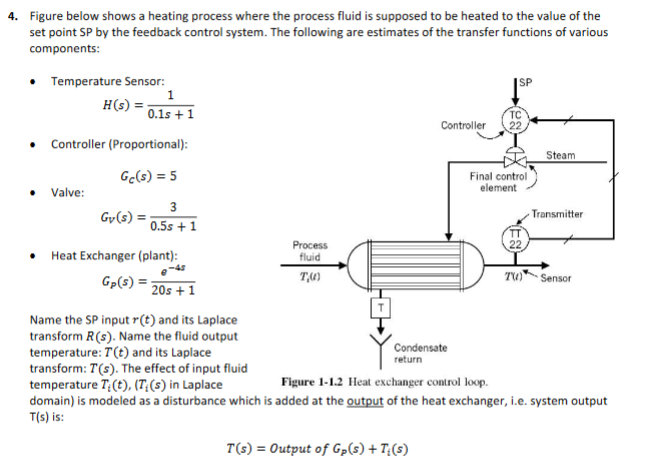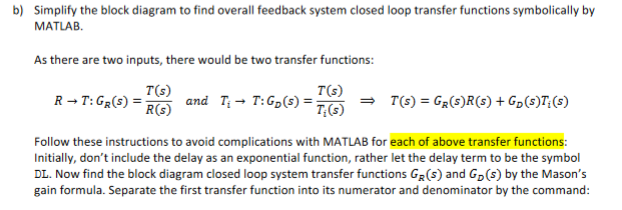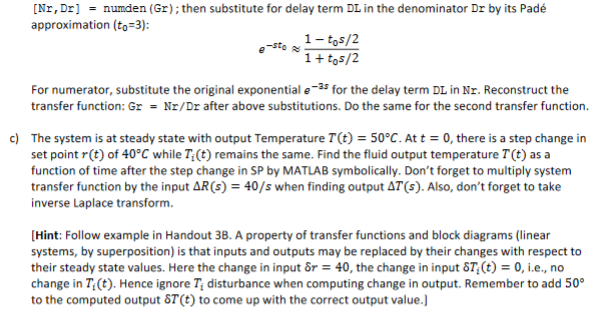4. Figure below shows a heating process where the process fluid is supposed to be heated to the value of the set point SP




4. Figure below shows a heating process where the process fluid is supposed to be heated to the value of the set point SP by the feedback control system. The following are estimates of the transfer functions of various components: Temperature Sensor: 1 H(s) = 0.1s+1 Controller (Proportional): Gc(s) = 5 Valve: 3 Gy(s) = 0.5s +1 Heat Exchanger (plant): Gp(s) = 20s +1 Name the SP input r(t) and its Laplace Process fluid T,() TC Controller 22 Steam Final control element Transmitter TW) Sensor transform R(s). Name the fluid output temperature: T(t) and its Laplace transform: T(s). The effect of input fluid temperature T(t), (T(s) in Laplace Condensate return Figure 1-1.2 Heat exchanger control loop. domain) is modeled as a disturbance which is added at the output of the heat exchanger, i.e. system output T(s) is: T(s) = Output of Gp(s) + T(s) b) Simplify the block diagram to find overall feedback system closed loop transfer functions symbolically by MATLAB. As there are two inputs, there would be two transfer functions: T(s) RT: GR(s) = R(s) and T T:G(s) = ; T(s) T(s) = GR(s)R(s) + G(s)T;(s) T(s) Follow these instructions to avoid complications with MATLAB for each of above transfer functions: Initially, don't include the delay as an exponential function, rather let the delay term to be the symbol DL. Now find the block diagram closed loop system transfer functions GR(s) and GD (s) by the Mason's gain formula. Separate the first transfer function into its numerator and denominator by the command: [Nr, Dr] = numden (Gr); then substitute for delay term DL in the denominator Dr by its Pad approximation (to=3): -sto 1-tos/2 1+ tos/2 For numerator, substitute the original exponential eas for the delay term DL in Nr. Reconstruct the transfer function: Gr = Nr/Dr after above substitutions. Do the same for the second transfer function. c) The system is at steady state with output Temperature T(t) = 50C. At t = 0, there is a step change in set point r(t) of 40C while Ti(t) remains the same. Find the fluid output temperature T(t) as a function of time after the step change in SP by MATLAB symbolically. Don't forget to multiply system transfer function by the input AR(s) = 40/s when finding output AT(s). Also, don't forget to take inverse Laplace transform. [Hint: Follow example in Handout 3B. A property of transfer functions and block diagrams (linear systems, by superposition) is that inputs and outputs may be replaced by their changes with respect to their steady state values. Here the change in input &r=40, the change in input 67,(t) = 0, i.e., no change in Ti(t). Hence ignore T disturbance when computing change in output. Remember to add 50 to the computed output ST (t) to come up with the correct output value.] d) Plot system temperature response T(t) found in part c by splot command for 0 st 150 seconds. Your plot of T(t) should begin at T = 50C and reach a steady state value. Some useful MATLAB command: Define symbols st: Substitution (see MATLAB help): Plot symbolic functions g(t) from t St St: syms st subs (...) fplot (gt, [t1, t2])
Step by Step Solution
There are 3 Steps involved in it
Step: 1
Sol...
See step-by-step solutions with expert insights and AI powered tools for academic success
Step: 2

Step: 3

Ace Your Homework with AI
Get the answers you need in no time with our AI-driven, step-by-step assistance
Get Started


